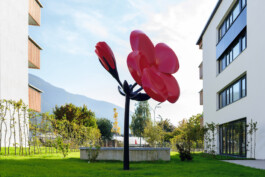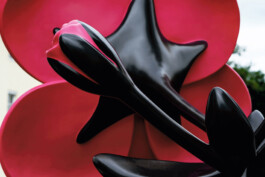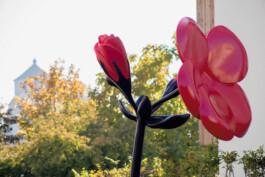The Geranium Blossom




Eine Geranienblüte, 2018; Photo: EBL Media Production OG
Eine Geranienblüte, 2018; Photo: EBL Media Production OG
Eine Geranienblüte, 2018; Photo: EBL Media Production OG
Eine Geranienblüte, 2018; Photo: EBL Media Production OG
Realization Kunst am Bau, Südtiroler Siedlung, Kufstein, AT, 2018
Realization: Paper Blattmacher, www.atelierblattmacher.de
The period of the so-called Great Option (1939 to 1043) was and is probably the most difficult and darkest chapter in the history of the South Tyrolean population. As 80 to 90% of South Tyroleans opted to emigrate, a deep emotional rift ran through society, dividing families and friendships. The emigrants and the Dableiber faced each other with great incomprehension: Each side considered the other to be traitors: some betrayed their homeland, others their culture. By 1943, 75,000 South Tyroleans had emigrated and were mainly accommodated in Austria in the so-called South Tyrolean settlements. One of these is the subject of this current art in architecture commission in Kufstein.
The geranium, which is popularly known as the “burning love” and still adorns many courtyards and houses in South Tyrol and Tyrol today, became a symbol of their respective movements for both the Dableiber and the Optanten. For the Dableiber, the geranium became a symbol of their identity and was hung in front of the windows as a flower of resistance. For the Optants, the flower became a symbol of longing and an image of pain and loss and was intended to provide comfort against homesickness in a foreign country.
By placing the geranium blossom on the central square in the middle of the South Tyrolean settlement, a new beginning can take place without blotting out the past. It is intended to stand there with dignity, as if it were a matter of course and completely free of value. It is not a mature blossom, but rather the image of a delicate bud that will soon open, which has already burst open a little in one place. Any kind of discussion and communication requires a sensitive counterpart. If the communicators treat each other with respect and a sense of awareness of each other’s vulnerability, the discussion can succeed and enrich everyone involved. The flower needs time and, above all, warmth, water and light. Then it can become a mature flower and bear fruit in the form of seeds. In this context, I see the geranium flower as a symbol of hope, the willingness of all those involved to engage in open, sensitive and unbiased dialog and an awareness of the tenderness and vulnerability of the other person.
The Geranium Blossom




Eine Geranienblüte, 2018; Photo: EBL Media Production OG
Eine Geranienblüte, 2018; Photo: EBL Media Production OG
Eine Geranienblüte, 2018; Photo: EBL Media Production OG
Eine Geranienblüte, 2018; Photo: EBL Media Production OG
Realization Kunst am Bau, Südtiroler Siedlung, Kufstein, AT, 2018
Realization: Paper Blattmacher, www.atelierblattmacher.de
The period of the so-called Great Option (1939 to 1043) was and is probably the most difficult and darkest chapter in the history of the South Tyrolean population. As 80 to 90% of South Tyroleans opted to emigrate, a deep emotional rift ran through society, dividing families and friendships. The emigrants and the Dableiber faced each other with great incomprehension: Each side considered the other to be traitors: some betrayed their homeland, others their culture. By 1943, 75,000 South Tyroleans had emigrated and were mainly accommodated in Austria in the so-called South Tyrolean settlements. One of these is the subject of this current art in architecture commission in Kufstein.
The geranium, which is popularly known as the “burning love” and still adorns many courtyards and houses in South Tyrol and Tyrol today, became a symbol of their respective movements for both the Dableiber and the Optanten. For the Dableiber, the geranium became a symbol of their identity and was hung in front of the windows as a flower of resistance. For the Optants, the flower became a symbol of longing and an image of pain and loss and was intended to provide comfort against homesickness in a foreign country.
By placing the geranium blossom on the central square in the middle of the South Tyrolean settlement, a new beginning can take place without blotting out the past. It is intended to stand there with dignity, as if it were a matter of course and completely free of value. It is not a mature blossom, but rather the image of a delicate bud that will soon open, which has already burst open a little in one place. Any kind of discussion and communication requires a sensitive counterpart. If the communicators treat each other with respect and a sense of awareness of each other’s vulnerability, the discussion can succeed and enrich everyone involved. The flower needs time and, above all, warmth, water and light. Then it can become a mature flower and bear fruit in the form of seeds. In this context, I see the geranium flower as a symbol of hope, the willingness of all those involved to engage in open, sensitive and unbiased dialog and an awareness of the tenderness and vulnerability of the other person.